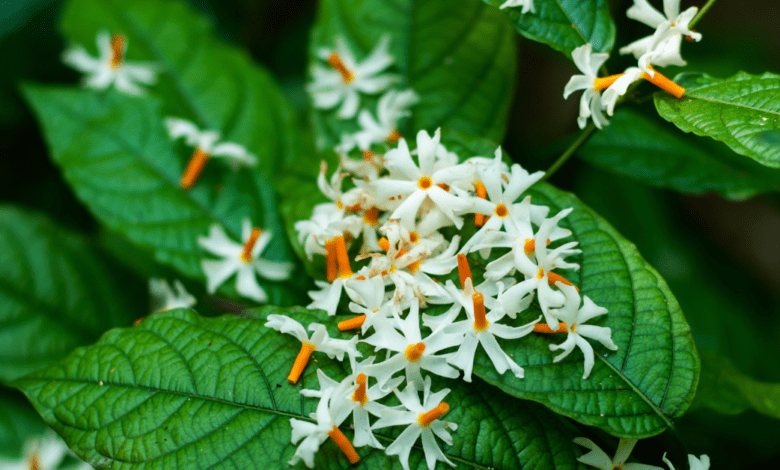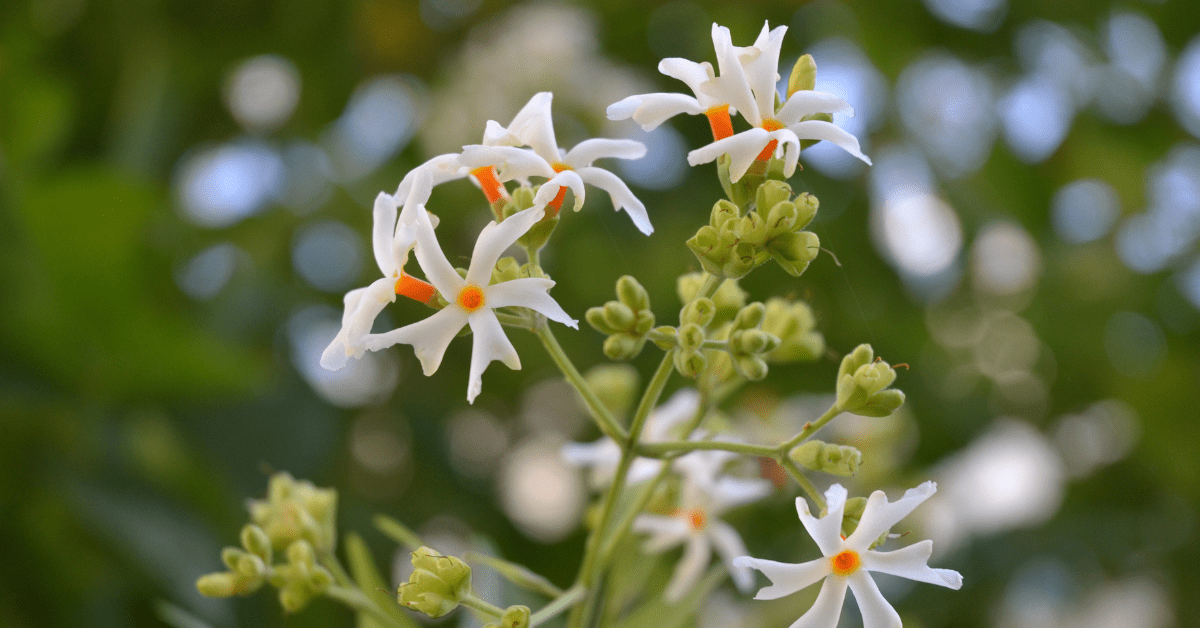A Guide to the Majesty of Night-Blooming Jasmine

In this comprehensive guide, we will delve into the origins, botanical details, fragrance, blooming schedule, and cultivation of the night-blooming jasmine, as well as its diverse applications in traditional medicine, aromatherapy, and its enduring presence in literature and folklore.
The Origins and Botanical Details
The night-blooming jasmine, scientifically known as Cestrum nocturnum, is a member of the Solanaceae family, which includes a diverse range of plants, such as tomatoes, potatoes, and eggplants. Native to the tropical regions of the Americas, it’s is found in countries like Mexico, the Caribbean, and parts of South America.
This woody, evergreen shrub can grow up to 15 feet (4.5 meters) in height, with slender, arching branches and lush, dark green foliage. The leaves are oblong in shape, measuring up to 6 inches (15 cm) in length, and have a smooth, glossy texture.
The true stars of the night-blooming jasmine, however, are its delicate, tubular flowers that emerge in clusters along the stems. These flowers, ranging from creamy white to pale yellow in color, open up in the evening hours, releasing their captivating fragrance to attract nocturnal pollinators such as moths and bats.
The night-blooming jasmine’s botanical classification and its unique adaptations to thrive in tropical environments have contributed to its enduring popularity and the fascination it has sparked among botanists, horticulturists, and nature enthusiasts alike.
The Fragrance of Night-Blooming Jasmine: A Sensory Delight
The captivating fragrance of the night-blooming jasmine is the primary reason for its enduring popularity and widespread cultivation. As the sun sets and the evening chill settles in, the delicate flowers begin to unfurl, releasing a scent that has been described as a harmonious blend of citrus, spice, and floral notes.
The fragrance of the night-blooming jasmine is often likened to a symphony of aromas, with each note playing a distinct role in creating a captivating and intoxicating scent. The citrus-like undertones provide a refreshing and uplifting element, while the spicy nuances add depth and complexity to the aroma. The floral notes, reminiscent of jasmine and other delicate blooms, lend a delicate and romantic quality to the overall fragrance.
This enchanting scent has made the night-blooming jasmine a highly sought-after ingredient in the world of perfumery, with its unique and alluring aroma being used to create a wide range of fragrances, from luxurious perfumes to soothing essential oils. Additionally, the night-blooming jasmine’s fragrance has been celebrated in various cultural and literary traditions, where it is often associated with themes of romance, mystery, and the enchantment of the night.
The Blooming Schedule of Night-Blooming Jasmine

The night-blooming jasmine is aptly named for its unique blooming schedule, which is tightly synchronized with the daily cycle of light and darkness. As the sun sets and the evening shadows lengthen, the delicate flowers of the night-blooming jasmine begin to unfurl, revealing their captivating beauty and releasing their intoxicating fragrance.
The blooming process typically begins around dusk, with the flowers gradually opening over the course of several hours. The peak of the night-blooming jasmine’s fragrance is often experienced in the late evening, as the flowers reach full bloom. This enchanting display of floral majesty typically lasts through the night, with the flowers closing up again as the first rays of dawn begin to illuminate the sky.
The synchronization of the night-blooming jasmine’s blooming schedule with the daily cycle of light and darkness is a remarkable adaptation that has evolved to attract nocturnal pollinators, such as moths and bats, which are drawn to the plant’s captivating fragrance. This unique trait has made the night-blooming jasmine a beloved and sought-after addition to gardens and landscapes, where its ethereal beauty and enchanting scent can be fully appreciated under the glow of the moon.
Growing and Caring for Night-Blooming Jasmine
Cultivating this enchanting beauty in one’s own garden or landscape can be a rewarding and enchanting experience. While this tropical plant may have specific growing requirements, with the right care and attention, it can thrive and bring its captivating beauty and fragrance to any outdoor space.
Soil and Sunlight Requirements:
- The night-blooming jasmine prefers well-draining, nutrient-rich soil with a slightly acidic pH.
- It thrives in areas that receive partial to full sun exposure, with at least 6 hours of direct sunlight per day.
Watering and Humidity:
- The night-blooming jasmine requires consistent moisture, but it is important to avoid overwatering, as this can lead to root rot.
- Maintaining adequate humidity levels around the plant is crucial, as it helps to mimic the tropical conditions of its native habitat.
Pruning and Maintenance:
- Regular pruning of the night-blooming jasmine is necessary to maintain its shape and encourage new growth.
- Deadheading spent flowers can help to prolong the blooming season and promote the development of new flowers.
Overwintering and Cold Tolerance:
- The night-blooming jasmine is generally not cold-hardy and may require protection or indoor cultivation in colder climates.
- Bringing the plant indoors during the winter months and providing it with ample sunlight can help to ensure its survival and continued growth.
By following these guidelines and providing the enchanting plant with the right growing conditions, gardeners can enjoy the enchanting beauty and captivating fragrance of this remarkable plant for years to come.
Popular Varieties
While the night-blooming jasmine (Cestrum nocturnum) is the most widely recognized and cultivated species, there are several other varieties that have gained popularity among horticulturists and gardeners:
- Cestrum elegans (Elegant Jasmine):
- Smaller in stature than the standard night-blooming jasmine
- Produces clusters of bright red or orange flowers
- Exhibits a slightly different fragrance profile, with more pronounced floral notes
- Cestrum diurnum (Day-Blooming Jasmine):
- As the name suggests, this variety blooms during the day rather than at night
- Flowers are typically white or pale yellow in color
- Fragrance is less intense than the night-blooming jasmine
- Cestrum parqui (Green Jasmine):
- Distinctive for its bright green foliage and yellow-green flowers
- Produces a more subtle, earthy fragrance compared to the night-blooming jasmine
- Considered more cold-hardy than other Cestrum species
- Cestrum newellii (Newell’s Jasmine):
- A compact, bushy variety with a dense, mounding growth habit
- Flowers are white or pale pink and possess a sweet, floral aroma
- Suitable for growing in containers or as a low-growing border plant
These diverse Cestrum species and varieties offer gardeners a range of options to explore the enchanting world of night-blooming jasmine, allowing them to incorporate the plant’s captivating beauty and fragrance into their outdoor spaces in unique and creative ways.
Utilizing Night-Blooming Jasmine in Landscaping and Gardens
The night-blooming jasmine’s captivating beauty and intoxicating fragrance make it a highly versatile plant for use in landscaping and garden design. Its adaptability to various growing conditions and its enchanting nighttime display make it a sought-after addition to both formal and informal garden settings.
Hedges and Borders: The night-blooming jasmine’s dense, evergreen foliage and arching growth habit make it an excellent choice for creating fragrant hedges and borders. When planted in rows or groups, the night-blooming jasmine can form a lush, visually striking backdrop that comes alive with its enchanting scent in the evening hours.
Specimen Plantings: As a standalone specimen plant, the night-blooming jasmine can be the focal point of a garden or landscape, drawing the eye and captivating the senses with its delicate flowers and mesmerizing fragrance. Strategically placing the plant near seating areas or pathways allows visitors to fully appreciate its enchanting display.
Container Gardening: The night-blooming jasmine’s adaptability to container cultivation makes it an excellent choice for small-space gardening, such as balconies, patios, or terraces. Potted specimens can be moved around to take advantage of the ideal growing conditions and to position the plant where its fragrance can be fully enjoyed.
Fragrant Courtyards and Moongardens: The night-blooming jasmine’s nocturnal blooming habit makes it a natural choice for creating enchanting “moongardens” or fragrant courtyards. When planted alongside other night-blooming or fragrant plants, the night-blooming jasmine can transform these outdoor spaces into serene, sensory-rich havens that come alive under the glow of the moon.
By incorporating the night-blooming jasmine into their landscaping and garden designs, homeowners and landscape architects can create truly captivating and memorable outdoor spaces that celebrate the plant’s enchanting beauty and fragrance.
Night-Blooming Jasmine in Traditional Medicine and Aromatherapy
In addition to its horticultural and ornamental applications, the night-blooming jasmine has also found a place in traditional medicine and the realm of aromatherapy, where its unique properties and captivating fragrance have been harnessed for their potential health benefits.
Traditional Medicine: In various traditional medicinal systems, the night-blooming jasmine has been used to treat a range of ailments. The leaves and flowers of the plant have been used in herbal remedies to address respiratory issues, such as coughs and asthma. Additionally, the plant’s sedative and anti-anxiety properties have been explored in traditional practices, with the night-blooming jasmine being used to promote relaxation and sleep.
Aromatherapy: The captivating fragrance of the night-blooming jasmine has made it a highly sought-after ingredient in the world of aromatherapy. The plant’s essential oils, extracted from the flowers, are believed to possess a range of therapeutic benefits. These include reducing stress and anxiety, promoting relaxation, and potentially enhancing mood and cognitive function.
When used in diffusers, candles, or topical applications, the night-blooming jasmine’s fragrance is thought to have a calming and uplifting effect, making it a popular choice for creating soothing and restorative aromatherapy experiences.
While the scientific research on the specific health benefits of the night-blooming jasmine is still ongoing, the plant’s long-standing use in traditional medicine and its growing popularity in the field of aromatherapy suggest that it may possess valuable therapeutic properties worth further exploration.
This Enchanting Plant in Literature and Folklore
The night-blooming jasmine’s enchanting beauty and captivating fragrance have not only captivated the hearts of gardeners and botanists but have also found a place in the rich tapestry of literature and folklore around the world.
Literary Representations: The night-blooming jasmine has been a recurring motif in various literary works, often serving as a symbol of romance, mystery, and the allure of the night. In the poetry of the Indian subcontinent, the night-blooming jasmine, known as “Raat Ki Rani” or “Queen of the Night,” is celebrated for its intoxicating scent and its ability to evoke a sense of enchantment and wonder.
Similarly, in the works of Latin American authors, the night-blooming jasmine has been used to evoke themes of sensuality, nostalgia, and the magical realism that permeates the region’s literary traditions.
Folkloric Traditions: In many cultures, the night-blooming jasmine has been imbued with symbolic and spiritual significance. In some Hindu traditions, the plant is associated with the goddess Lakshmi, the embodiment of wealth, prosperity, and beauty. The night-blooming jasmine’s delicate flowers are often used in religious rituals and offerings, reflecting its sacred status.
Additionally, in certain Caribbean and South American folklore, the night-blooming jasmine is believed to possess protective and purifying properties, with the plant being used in rituals and ceremonies to ward off negative energies and promote spiritual well-being.
The enduring presence of this beautiful plant in literature and folklore underscores the deep cultural resonance and the captivating allure of this enchanting plant, which continues to inspire and captivate the human imagination.
Celebrating the Enchanting Beauty of Night-Blooming Jasmine
The night-blooming jasmine is a truly remarkable plant, one that has captivated the hearts and imaginations of people around the world for centuries. From its intoxicating fragrance that fills the evening air to its delicate, ethereal blooms that seem to glow under the moonlight, the enchanting plant is a testament to the beauty and wonder of the natural world.
Whether you are a passionate gardener, a lover of fragrant plants, or simply someone who appreciates the enchantment of the night, the beautiful plant deserves a place in your outdoor space. By cultivating and caring for this remarkable flower, you can create a sensory experience that will transport you to a realm of beauty, serenity, and enchantment.
So, as the sun sets and the night-blooming jasmine begins to unfurl its delicate flowers, take a moment to bask in the captivating fragrance and the ethereal beauty of this truly remarkable plant. Let its enchanting presence inspire you to celebrate the natural world and the myriad wonders it has to offer.
Discover the enchanting beauty of night-blooming jasmine and transform your outdoor space into a sensory oasis. Explore our selection of night-blooming jasmine plants and accessories to bring the magic of this captivating flower into your own garden or landscape. Visit our website today to learn more and start your journey into the world of night-blooming jasmine.




